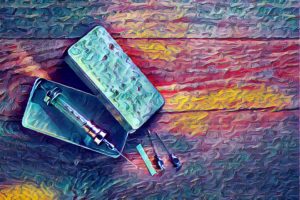
John’s Story – The late lure of ice
My name is John, and I would like to talk about some of my drug using experiences and how I…
Ketamine (also known as ket, K, special K, or horse tranquiliser) is a dissociative anaesthetic belonging to a class of drugs called arylcyclohexylamines, which also includes PCP, methoxetamine and others.1 Ketamine is commonly used as an anaesthetic in human and veterinary medicine but, at lower doses, it is used recreationally as a dissociative drug.1 Recreationally, ketamine is most commonly snorted, injected, or taken orally.1 Ketamine can be habit-forming and psychological dependence is reported within the community.1
Ketamine was first synthesised in the early 1960s and came into use as an anaesthetic in the late 1960s, replacing PCP.1,2 Over the last two decades, ketamine has gained the attention of psychiatrists for its rapid-acting antidepressant effects.2 It has been studied and prescribed off-label for the treatment of several psychiatric disorders, including depression, complex trauma, bipolar disorder and PTSD.2,3 Ketamine is usually only given during or in addition to psychotherapy to people who have already tried other treatments.2,3 The beneficial effects of ketamine for psychiatric disorders may be due to its ability to reduce fear when accessing difficult states of mind, to reduce negative emotions, and to enhance a person’s ability to engage in psychotherapy.3
Unfortunately, ketamine sold on the street is not always ketamine. Ketamine is commonly sold as a white, crystalline powder and it is very easy to mix with cutting agents and other drugs.1 Of the 81 samples tested at CanTEST which were expected to be ketamine, only 57% actually contained ketamine as of April 2023.4 Other drugs have been sold as ketamine which are not well studied in humans and may cause unexpected or adverse effects.5 Hence, it is especially important to test ketamine before taking it either by using reagent test kits at home (e.g., https://dancesafe.org/product/ketamine-testing-kit/) or by taking it to a drug checking site (e.g., https://www.cahma.org.au/services/cantest/).
Ketamine is an anaesthetic, so high doses have the potential to cause the loss of a person’s ability to move and loss of consciousness.1 For this reason, it is important for a person taking ketamine to let someone else know they’ve taken it or preferably to have a trusted, sober person nearby to assist them if needed.
The effects of ketamine can include:1,2,3,6
The peak effects of ketamine typically last 1-2 hours regardless of the route of administration.7 The onset of effects is quickest for injecting (< 7.5 minutes) and slowest for oral (10-75 minutes).7 Snorting usually takes 7.5-20 minutes for the effects to appear.7 After the peak effects wear off, people can experience subtle psychological effects lasting a day or longer.1
The purity and thus potency of ketamine sold on the street can vary widely since it is easy to mix with cutting agents. It is always recommended to start at a low dose and wait before redosing recreational drugs (start low and go slow).
The common doses for snorted ketamine are as follows:7
LOW DOSE – 20-50 mg
MEDIUM DOSE – 50-125 mg
STRONG DOSE – 125-175 mg
HEAVY DOSE, POSSIBLE ANAESTHESIA – 175+ mg
The doses can be different depending on the route of administration.1 Injecting ketamine, either intramuscularly or intravenously, may require a smaller dose to achieve the same effects.1 Ketamine is poorly absorbed when swallowed, so oral administration may have diminished effects.1,3
Ketamine is widely used at high doses for anaesthesia in humans.1 Hence, ketamine is relatively safe even at high doses.1 However, unexpectedly high doses, particularly in an unsafe environment, can result in injury due to loss of coordination, motor control or consciousness.1 If someone has taken an unexpectedly high dose of ketamine, encourage them to sit or lie down in a safe place.
Mixing ketamine with other depressants–including alcohol, GHB and opioids–is considered dangerous since the combination greatly increases the risk of vomiting, loss of coordination, and unconsciousness.7 If a person is struggling to maintain consciousness while combining these substances:
Taking a heavy dose of ketamine results in a state which is popularly called a “k-hole”.1 A k-hole consists of complete dissociation and partial anaesthesia but allows the user to retain some degree of consciousness and memory of the experience.1 Some users seek a k-hole when taking ketamine but it can be difficult to choose the correct dose since taking too much can cause full anaesthesia resulting in no memory of the experience.1
If someone is taking a high dose of ketamine or seeking a k-hole, it is particularly beneficial to have a trusted, sober person nearby to assist them if needed, commonly called a “tripsitter”. A tripsitter can assist the person by giving them water, engaging in conversation when needed, helping to move them around and generally keeping them comfortable throughout the experience. A tripsitter can be present in a separate room and stay mostly uninvolved until the person calls on them or they can simply check on the person periodically.
Regular consumption of ketamine can cause symptoms similar to a urinary tract infection.8 This has been called ketamine bladder syndrome or ketamine-induced cystitis.8 Frequent use of ketamine can result in damage to the lining of the bladder and kidney damage which becomes more pronounced at higher doses.8 Symptoms of ketamine bladder syndrome can include:8
Stopping ketamine use has been observed to improve these symptoms.8 If you are experiencing these symptoms and are concerned, consider visiting a non-judgmental health professional such as the GP or nurse at the CAHMA clinic: https://www.cahma.org.au/services/cahma-clinic/.
References
[1] https://wiki.tripsit.me/wiki/Ketamine
[2] https://doi.org/10.1192/bjo.2021.1061
[3] https://doi.org/10.1080/02791072.2019.1587556
[4] https://health.act.gov.au/sites/default/files/2023-07/CanTEST%20Final%20Evaluation%20Report_2023.pdf
[5] https://www.cahma.org.au/wp-content/uploads/2022/10/1.jpg
[6] https://psychonautwiki.org/wiki/Ketamine
[7] https://drugs.tripsit.me/ketamine
[8] https://doi.org/10.52965/001c.38247
Written by Darcy Lynch

My name is John, and I would like to talk about some of my drug using experiences and how I…

I’ve lived in Canberra my whole life, I am twenty seven and have been addicted to opioids since I was…

My name is Rob. I’m 27 years old and lived in Canberra for my whole life. I started using drugs…